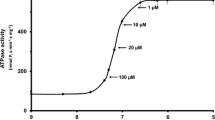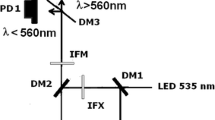Summary
Oxalate-supported Ca accumulation by the sarcoplasmic reticulum (SR) of chemically skinned mammalian skeletal muscle fibers is activated by MgATP and Ca2+ and partially inhibited by caffeine. Inhibition by caffeine is greatest when Ca2+ exceeds 0.3 to 0.4 μm, when free ATP exceeds 0.8 to 1mm, and when the inhibitor is present from the beginning of the loading period rather than when it is added after Ca oxalate has already begun to precipitate within the SR. Under the most favorable combination of these conditions, this effect of caffeine is maximal at 2.5 to 5mm and is half-maximal at approximately 0.5mm. For a given concentration of caffeine, inhibition decreases to one-half of its maximum value when free ATP is reduced to 0.2 to 0.3mm. Varying free Mg2+ (0.1 to 2mm) or MgATP (0.03 to 10mm) has no effect on inhibition. Average residual uptake rates in the presence of 5mm caffeine atpCa 6.4 range from 32 to 70% of the control rates in fibers from different animals. The extent of inhibition in whole-muscle homogenates is similar to that observed in skinned fibers, but further purification of SR membranes by differential centrifugation reduces their ability to respond to caffeine. In skinned fibers, caffeine does not alter the Ca2+ concentration dependence of Ca uptake (K 0.5, 0.5 to 0.8 μm; Hilln, 1.5 to 2.1). Reductions in rate due to caffeine are accompanied by proportional reductions in maximum capacity of the fibers, and this configuration can be mimicked by treating fibers with the ionophore A23187. Caffeine induces a sustained release of Ca from fibers loaded with Ca oxalate. However, caffeine-induced Ca release is transient when fibers are loaded without oxalate. The effects of caffeine on rate and capacity of Ca uptake as well as the sustained and transient effects on uptake and release observed under different conditions can be accounted for by a single mode of action of caffeine: it increases Ca permeability in a limited population of SR membranes, and these membranes coexist with a population of caffeine-insensitive membranes within the same fiber.
Similar content being viewed by others
References
Brandt, P.W., Cox, R.N., Kawai, M. 1980. Can the binding of Ca2+ to the regulatory sites on troponin-C determine the steep pCa/tension relationship of skeletal muscle?Proc. Natl. Acad. Sci. USA 77:4717–4720
Briggs, F.N., Poland, J.L., Solaro, R.J. 1977. Relative capabilities of sarcoplasmic reticulum in fast and slow mammalian skeletal muscles.J. Physiol. (London) 266:587–594
Chapman, R.A., Miller, D.J. 1974. Structure-activity relations for caffeine: A comparative study of the inotropic effects of the methylxanthines, imidazoles and related compounds on the frog's heart.J. Physiol. (London) 242:615–634
Chiarandini, D.J., Reuben, J.P., Brandt, P.W., Grundfest, H. 1970. Effects of caffeine on crayfish muscle fibers. I. Activation of contraction and induction of Ca spike electrogenesis.J. Gen. Physiol. 55:640–664
Chiarandini, D.J., Reuben, J.P., Girardier, L., Katz, G.M., Grundfest, H. 1970. Effects of caffeine on crayfish muscle fibers. II. Refractoriness and factors influencing recovery (repriming) of contractile responses.J. Gen. Physiol. 55:665–687
Chiesi, M., Wen, Y.S. 1983. A phosphorylated conformational state of the (Ca2+−Mg2+)-ATPase of fast skeletal muscle sarcoplasmic reticulum can mediate rapid Ca2+ release.J. Biol. Chem. 258:6078–6085
De Meis, L., Hasselbach, W. 1971. Acetylphosphate as substrate for Ca2+ uptake in skeletal muscle microsomes.J. Biol. Chem. 246:4759–4763
De Meis, L., Vianna, A.L. 1979. Energy interconversion by the Ca2+-dependent ATPase of the sarcoplasmic reticulum.Annu. Rev. Biochem. 48:275–292
Eastwood, A.B., Wood, D.S., Bock, K.L., Sorenson, M.M. 1979. Chemically skinned mammalian skeletal muscle. I. The structure of skinned rabbit psoas.Tissue Cell 11:553–566
Endo, M. 1975. Mechanism of action of caffeine on the sarcoplasmic reticulum of skeletal muscle.Proc. Jpn. Acad. 51:479–484
Endo, M., Kitazawa, T. 1976. The effect of ATP on calcium release mechanisms in the sarcoplasmic reticulum of skinned muscle fibers.Proc. Jpn. Acad. 52:595–598
Endo, M., Tanaka, M., Ogawa, Y. 1970. Calcium-induced release of calcium from the sarcoplasmic reticulum of skinned skeletal muscle fibres.Nature (London) 228:34–36
Fabiato, A., Fabiato, F. 1979. Calculator programs for computing the concentrations of the solutions containing multiple metals and ligands used for experiments in skinned muscle cells.J. Physiol. (Paris) 75:463–505
Fairhurst, A.S. 1974. A ryanodine-caffeine sensitive membrane fraction of skeletal muscle.Am. J. Physiol. 227:1124–1131
Fairhurst, A.S., Hasselbach, W. 1970. Calcium efflux from a heavy sarcotubular fraction: Effects of ryanodine, caffeine and magnesium.Eur. J. Biochem. 13:504–509
Feher, J.J., Briggs, N. 1980. The effect of calcium oxalate crystallization kinetics on the kinetics of calcium uptake and calcium ATPase activity of sarcoplasmic reticulum vesicles.Cell Calcium 1:105–118
Frank, G.B. 1962. Utilization of bound calcium in the action of caffeine and certain multivalent cations on skeletal muscle.J. Physiol. (London) 163:254–268
Fuchs, F. 1969. Inhibition of sarcotubular calcium transport by caffeine: Species and temperature dependence.Biochim. Biophys. Acta 172:566–570
Hasselbach, W. 1966. Structural and enzymatic properties of the calcium transporting membranes of the sarcoplasmic reticulum.Ann. N.Y. Acad. Sci. 137:1041–1048
Johnson, P.N., Inesi, G. 1969. The effect of methylxanthines and local anesthetics on fragmented sarcoplasmic reticulum.J. Pharmacol. Exp. Ther. 169:308–314
Katz, A.M., Repke, D.I., Hasselbach, W. 1977. Dependence of ionophore- and caffeine-induced calcium release from sarcoplasmic reticulum vesicles on external and internal calcium ion concentrations.J. Biol. Chem. 252:1938–1949
Kim, D.H., Ohnishi, S.T., Ikemoto, N. 1983. Kinetic studies of calcium release from sarcoplasmic reticulumin vitro.J. Biol. Chem. 258:9662–9668
Kirino, Y., Osakabe, M., Shimizu, H. 1983. Ca2+-induced Ca2+ release from fragmented sarcoplasmic reticulum: Ca2+-dependent passive Ca2+ efflux.J. Biochem. 94:1111–1118
Kirino, Y., Shimizu, H. 1982. Ca2+-induced Ca2+ release from fragmented sarcoplasmic reticulum: A comparison with skinned muscle fiber studies.J. Biochem. 92:1287–1296
Kitazawa, T., Endo, M. 1976. Increase in passive calcium influx into the sarcoplasmic reticulum by “depolarization” and caffeine.Proc. Jpn. Acad. 52:599–602
Koeppe, P., Hamann, C. 1980. A program for non-linear regression analysis to be used on desk-top computers.Comput. Prog. Biomed. 12:121–128
Lowry, O.H., Rosebrough, N.J., Farr, A.L., Randall, R.J. 1951. Protein measurement with the Folin phenol reagent.J. Biol. Chem. 193:265–275
Lüttgau, H.C., Oetliker, H. 1968. The action of caffeine on the activation of the contractile mechanism in striated muscle fibers.J. Physiol. (London) 194:51–74
Meissner, G. 1975. Isolation and characterization of two types of sarcoplasmic reticulum vesicles.Biochim. Biophys. Acta 389:51–68
Meissner, G. 1984. Adenine nucleotide stimulation of Ca2+-induced Ca2+ release in sarcoplasmic reticulum.J. Biol. Chem. 259:2365–2374
Meissner, G., Conner, G.E., Fleischer, S. 1973. Isolation of sarcoplasmic reticulum by zonal centrifugation and purification of Ca2+-pump protein and Ca2+-binding proteins.Biochim. Biophys. Acta 298:246–269
Miledi, R., Stefani, E. 1969. Non-selective re-innervation of slow and fast muscle fibres in the rat.Nature (London) 222:569–571
Millman, M., Azari, J. 1977. Adenosine-triphosphate-induced rapid calcium release from fragmented sarcoplasmic reticulum.Biochem. Biophys. Res. Commun. 78:60–66
Miyamoto, H., Racker, E. 1982. Mechanism of calcium release from skeletal sarcoplasmic reticulum.J. Membrane Biol. 66:193–201
Nagasaki, K., Kasai, M. 1981. Calcium-induced calcium release from sarcoplasmic reticulum vesicles.J. Biochem. 90:749–755
Nagasaki, K., Kasai, M. 1983. Fast release of calcium from sarcoplasmic reticulum vesicles monitored by chlortetracycline fluorescence.J. Biochem. 94:1104–1109
Ogawa, Y. 1970. Some properties of fragmented frog sarcoplasmic reticulum with particular reference to its response to caffeine.J. Biochem. 67:667–683
Ogawa, Y., Ebashi, S. 1973. Ca2+ uptake and release by fragmented sarcoplasmic reticulum with special reference to the effect of β,γ-methylene adenosine triphosphate.In: Organization of Energy-transducing Membranes. M. Nakao and L. Packer, editors. pp. 127–140. University Park Press, Tokyo
Ohnishi, S.T. 1979. Calcium-induced calcium release from fragmented sarcoplasmic reticulum.J. Biochem. 86:1147–1150
Solaro, R.J., Briggs, F.N. 1974. Estimating the functional capabilities of sarcoplasmic reticulum in cardiac muscle.Circ. Res. 34:531–540
Somlyo, A.V., Gonzales-Serratos, H., Shuman, H., McClellan, G., Somlyo, A.P. 1982. Calcium release and ionic changes in the sarcoplasmic reticulum of tetanized muscle: An electron-probe study.J. Cell Biol. 90:577–594
Sorenson, M., Coelho, H.S.L. 1984. Caffeine inhibition of calcium accumulation by the sarcoplasmic reticulum in mammalian skeletal muscle fibers.Braz. J. Med. Biol. Res. 17:398
Sorenson, M., Coelho, H.S.L. 1985. Caffeine inhibition of Ca++ accumulation in skinned fibers.Biophys. J. 47:452a
Sorenson, M., Eastwood, A.B., Reuben, J.P. 1978. Caffeine sensitivity of the sarcoplasmic reticulum: Heterogeneous distribution within sarcomeres of skinned fibers.VIth Intl. Congr. Biophys., Kyoto, p. 234
Sorenson, M.M., Reuben, J.P., Eastwood, A.B., Orentlicher, M., Katz, G.M. 1980. Functional heterogeneity of the sarcoplasmic reticulum within sarcomeres of skinned muscle fibers.J. Membrane Biol. 53:1–17
Stephenson, E.W. 1981. Ca2+ dependence of stimulated45Ca efflux in skinned muscle fibers.J. Gen. Physiol. 77:419–443
Su, J.Y., Hasselbach, W. 1984. Caffeine-induced calcium release from isolated sarcoplasmic reticulum of rabbit skeletal muscle.Pfluegers Arch. 400:14–21
Verjovski-Almeida, S., Inesi, G. 1979. Fast-kinetic evidence for an activating effect of ATP on the Ca2+ transport of sarcoplasmic reticulum ATPase.J. Biol. Chem. 254:18–21
Vianna, A.L. 1975. Interaction of calcium and magnesium in activating and inhibiting the nucleoside triphosphatase of sarcoplasmic reticulum vesicles.Biochim. Biophys. Acta 410:389–406
Volpe, P., Mrak, R.E., Costello, B., Fleischer, S. 1984. Calcium release from sarcoplasmic reticulum of normal and dystrophic mice.Biochim. Biophys. Acta 769:67–78
Weber, A. 1968. The mechanism of action of caffeine on sarcoplasmic reticulum.J. Gen. Physiol. 52:760–772
Weber, A., Herz, R. 1968. The relationship between caffeine contracture of intact muscle and the effect of caffeine on reticulum.J. Gen. Physiol. 52:750–759
Winegrad, S. 1968. Intracellular calcium movements of frog skeletal muscle during recovery from a tetanus.J. Gen. Physiol. 51:65–83
Wood, D.S. 1978. Human skeletal muscle: Analysis of Ca2+ regulation in skinned fibers using caffeine.Exp. Neurol. 58:218–230
Wood, D.S., Kahn, D.A., Selinger, S., Reuben, J.P. 1977. Regulation of Ca++ efflux from the SR by ATP, Mg++ and Pi in the absence of substrate in skinned mammalian skeletal muscle.Biophys. J. 17:201
Wood, D.S., Zollman, J., Reuben, J.P., Brandt, P.W. 1975. Human skeletal muscle: Properties of the “chemically skinned” fiber.Science 187:1075–1076
Author information
Authors and Affiliations
Rights and permissions
About this article
Cite this article
Sorenson, M.M., Coelho, H.S.L. & Reuben, J.P. Caffeine inhibition of calcium accumulation by the sarcoplasmic reticulum in mammalian skinned fibers. J. Membrain Biol. 90, 219–230 (1986). https://doi.org/10.1007/BF01870128
Received:
Revised:
Issue Date:
DOI: https://doi.org/10.1007/BF01870128




